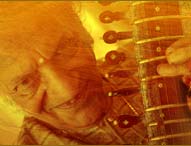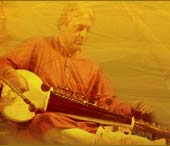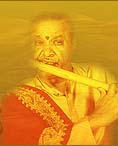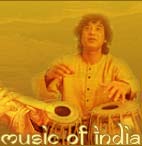The Santoor is a trapezoid-shaped musical instrument. Santoor is usually made of walnut, with numerous strings and is said to be related to the shata-tantri veena of earlier times. A lightweight wooden hammer is used to play the Santoor/ Santur, and is known as Mezrab. The bottom of the Santoor is made of plywood or veneer. To play the Santoor, these mallets (mezrab) are held between the index and middle fingers. A typical Santoor has two sets of bridges, providing a range of three octaves. The Santoor is played while sitting in a particular way, holding it in a specific position. The asana in which one must sit while playing Santoor is called ardha-padmasana position with the instrument being placed on top of the lap. Santoor can be played using both the hands, but the player has to be skillful as it is a very sensitive instrument and can vary in tones with little touches.
History
Santoor is believed to have an Iranian origin, which later had spread to other parts of Asia. The traditional Santoor was made of bark of a tree with strings made of goat's intestines. Santoor in Sanskrit was called "Shatha Tantri Veena", which means a lute or a stringed instrument that has hundred or more strings to it. Although there are many people who believe that origin of Santoor lies in Iran, yet there is another theory which says that gypsies from India must have travelled to many parts of Europe and thus carried this music instrument and its art with them. However many versions of Santoor is found all over the world. In India, earlier Santoor was produced only in Kashmir but today it is being produced Mumbai, Delhi, Kolkata and Punjab. In India, the credit of popularizing Santoor goes to Pandit Shiv Kumar Sharma.
Types of Santoor
It is interesting to note that the Kashmiri Santoor is more rectangular and usually has more strings than the original Persian Santoor. In Kashmiri classical music the Santoor is played with a pair of curved mallets, which are made of walnut wood and the produced melody resembles that of the harp, harpsichord or piano. The sound chamber of the Santoor is also made of walnut wood, while the bridges are made using local wood. The strings, another important part of Santoor, are made of imported steel. There are many instruments that are derived from Santoor. Chinese yangqin and Greek santouri are the derived versions on Santoor. The original Santoor was supposed to have hundred strings attached to it but the one that Pandit Shiv Kumar uses has 31 bridges and 91 strings. This has become the standard now and most of the manufacturers keep this in mind and produce the same.
Occasions
Santoor was traditionally played during festivities and celebrations, but in present era there are many concerts and music festivals where music lovers come and enjoy the soothing music played on the instrument. There are recorded Santoor CDs and DVDs available in market that you can pick and enjoy at your leisure. Listening to Santoor is balm to a stressed mind.
Famous Santoor Players
Prominent exponents of Santoor in the twentieth century include Pandit Shiv Kumar Sharma and Pandit Bhajan Sopori. Some other distinguished Santoor players of the contemporary generation include Abhay Rustum Sopori and Rahul Sharma. Other notable Santoor players of India are Roshan Ali, Harjinderpal Singh and Kiranpal Singh Deoora, Saurav Chatterjee, Kakan Ghosal, Versha Aggarwal, Rajkumar Majumdar, Charukeshi Shahane, Gulfam Sabri, Sandip Chatterjee and Bipul Ray.






